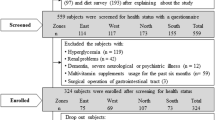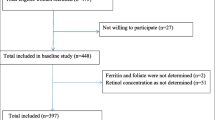Abstract
Prevalence of anemia in India is almost 40% with no significant change since 1998–99, whereas globally this prevalence has been reduced to < 15%. This could be because our national nutritional programs (mainly National Nutritional Anemia Control Program-NNACP) focus on supplementation with iron and folate but not with vitamin B12. Some Indian studies, including our study (2012), indicated high prevalence of B12 deficiency in North Indian urban population. Hence, we conducted a retrospective analysis of 3 years’ data (2012–2014 including 48,317 subjects) and compared it with last year’s retrospective data (April 2019–March 2020 including 4775 subjects) to ascertain prevalence of deficiencies of these micronutrient with special reference to patients of anemia, and improvement therein over the subsequent 5-year period. Our results indicate that amongst our subjects with anemia, iron deficiency has reduced from 66.73% (2012–2014) to 56.86% (2019), but prevalence of vitamin B12 deficiency is still the same (36.54% in 2012–2014; 37.04% in 2019). Folate deficiency was similar in both sets of data (2.95% in 2012–2014 and 2.55% in 2019). Thus, NNACP has reduced prevalence of iron deficiency by ~ 10%points and folate deficiency marginally; B12 deficiency has not been addressed. It would, therefore, follow that we need to add to our current national programs to effectively deal with these deficiencies. Food fortification (with iron, folate and B12) seems the most likely means to add value to the existing programs. In addition, food diversification needs to be included in regular school curriculum to bring about community awareness and change in food habits.


Similar content being viewed by others
References
Bhargava S, Ali A, Bhargava EK, Manocha A, Kankra M, Das S, et al. Lowering homocysteine and modifying nutritional status with folic acid and vitamin B12 in Indian patients of vascular disease. J Clin Biochem Nutr. 2012;50(3):222–6.
de Benoist B, McLean E, Egli I, Cogswell M. Worldwide prevalence of anaemia 1993–2005. WHO Global Database on Anaemia; 2008. pp. 21–31.
Kumar A. National nutritional anaemia control program in India. Indian J Public Health. 1999;43(1):3–5.
Upadhyay RP, Palanivel C, Kulkarni V. Unrelenting burden of anaemia in India: Highlighting possible prevention strategies. Int J Med Public Health. 2012;2(4):1–6. https://doi.org/10.5530/ijmedph.2.4.1.
Toteja GS, Singh P. Policy and Program implications in Micronutrient profile of Indian population. Published by Indian Council of Medical Research; 2004.
Global Data. 2018 https://www.globaldata.com/india-highest-prevalence-anaemia-among-16-major-pharma-markets-finds-globaldata/. Accessed Sep 2019.
International Institute for Population Sciences and ICF. National Family Health Survey (NFHS-4), 2015–16: India; 2017 Mumbai: IIPS.
Kotecha PV. Nutritional anaemia in young children with focus on Asia and India. Indian J Community Med. 2011;36(1):8–16.
WHO, UNICEF, UNU. Iron deficiency anaemia: assessment, prevention and control, a guide for programme managers. Geneva, World Health Organization; 2001. Available from http://www.who.int/nutrition/publications/micronutrients/anaemia_iron_deficiency/WHO_NHD_01.3/en/index.html
Pathak P, Kapil U, Yajnik CS, Kapoor SK, Dwivedi SN, Singh R. Iron, folate and vitamin B12 stores among pregnant women in a rural area of Haryana state, India. Food Nutr Bull. 2007;28(4):435–8.
García-Casal MN, Osorio C, Landaeta M, Leets I, Matus P, Fazzino F, et al. High prevalence of folic acid and vitamin B12 deficiencies in infants, children, adolescents and pregnant women in Venezuela. Eur J Clin Nutr. 2005;59(9):1064–70.
Ahmed F, Khan MR, Banu CP, Qazi MR, Akhtaruzzaman M. The coexistence of other micronutrient deficiencies in anaemic adolescent schoolgirls in rural Bangladesh. Eur J Clin Nutr. 2008;62(3):365–72.
Bhardwaj A, Kumar D, Raina SK, Bansal P, Bhushan S, Chander V. Rapid assessment of coexistence of vitamin B12 and iron deficiency anaemia among adolescent males and females in a Northern Himalayan state of India. Anaemia. 2013. https://doi.org/10.1155/2013/959605.
Refsum M, Yajnik CS, Gadkari M, Schneede J, Vollset SE, Orning L, et al. Hyperhomocysteinemia and elevated methylmalonic acid indicate a high prevalence of cobalamin deficiency in Asian Indians. Am J Clin Nutr. 2001;74:233–41.
Antony AC. Prevalence of cobalamin (vitamin B12) and folate deficiency in India—audi alteram partem (Editorial). Am J Clin Nutr. 2001;74:157–9.
Balaji LN, Dustagheer A. Nutrition scenario in India—implications for clinical practice. J Indian Med Assoc. 2000;98(536–8):542 (PMID: 11291786).
Mathan VI. Tropical sprue in Southern India. Trans R Soc Trop Med Hyg. 1988;82:10–4.
Kumari R, Bharti RK, Singh K, Sinha A, Kumar S, Saran A, et al. Prevalence of iron deficiency and iron deficiency anaemia in adolescent girls in a tertiary care hospital. J Clin Diagn Res. 2017;11(8):04–6.
Muir A, Hopfer U. Regional specificity of iron uptake by small intestinal brush-boarder membranes from normal and iron deficient mice. Am J Physiol. 1985;248:G376–9.
WHO/CDC (2004). Expert consultation agrees on best indicators to assess iron deficiency, a major cause of anaemia. http://www.who.int/mediacentre/news/notes/2004/anaemia/en. Accessed Dec 2020.
Chugh PK, Lamo Y. An assessment of vitamin supplements in the Indian market. Indian J Pharm Sci. 2012;74(5):469–73.
Radimer K, Bindewald B, Hughes J, Ervin B, Swanson C, Picciano MF. Dietary supplement use by US adults: data from the national health and nutrition examination survey, 1999–2000. Am J Epidemiol. 2004;160(4):339–49.
Chaudhary S, Firdaus U, Ali SM, Mahdi AA. Factors Associated with elevated blood lead levels in children. Indian Pediatr. 2018;55:38–40.
Black MM. Nutrition and brain development. In: Walker WA, Duggan C, Watkins JB, editors. Nutrition in pediatrics. New York: BC Decker; 2003. p. 386–96.
Andrès E, Loukili NH, Esther Noel E, Kaltenbach G, Abdelgheni MB, Perrin AE, et al. Vitamin B12 (cobalamin) deficiency in elderly patients. Can Med Assoc J. 2004;171(3):251–9.
Viola-Villegas N, Rabideau AE, Bartholomä M, Zubieta J, Doyle RP. Targeting the cubilin receptor through the vitamin B(12) uptake pathway: cytotoxicity and mechanistic insight through fluorescent Re(I) delivery. J Med Chem. 2009;52(16):5253–61.
Dali-Youcef N, Andres E. An update on cobalamin deficiency in adults. QJ Med. 2009;102:17–28.
Bhargava S, Tyagi SC. Nutriepigenetic regulation by folate-homocysteine-methionine axis: a review. Mol Cellular Biochem. 2014;387(1–2):55–61. https://doi.org/10.1007/s11010-013-1869-2.
Shenkin A, Roberts NB. Vitamins and trace elements. In: Burtis A, Bruns S, editors. Tietz textbook of clinical chemistry and molecular diagnostics. Philadelphia: Elsevier; 2006. p. 895–983.
Wills L. Treatment of “pernicious anaemia of pregnancy” and “tropical anaemia” with special reference to yeast extract as a curative agent. Br Med J. 1931;1:1059–64.
Martins JM. Universal iron fortification of foods: the view of a haematologist. Rev Bras Hematol Hemoter. 2012;34(6):459–63.
Report of Joint FAO/WHO Expert Consultation on vitamin and mineral requirement in human nutrition: Bangkok 1998. Second Edition FAO Rome, 2004. http://whqlibdoc.who.int/publications/2004/9241546123.pdf. Accessed Dec 2019.
World Health Organisation Team Nutrition. The role of food fortification in the control of micronutrient malnutrition. In ‘Guidelines on food fortification with micronutrients’ 2004. https://www.who.int/nutrition/publications/guide_food_fortification_micronutrients.pdf. Accessed Jan 2020.
Acknowledgements
The authors would like to thank Ms.Jyoti Punjabi, Ms. Naushba Parveen, Mr.Virender Singh, Mr. Deepak Tuteja and Ms.Vinita Rawat for their contribution in extraction, compilation and tabulation of data. The authors also thank Dr.Satish Saluja for his advice in statistical analysis.
Funding
This research received no specific grant from any funding agency, commercial or not-for-profit sectors.
Author information
Authors and Affiliations
Corresponding author
Ethics declarations
Conflict of interest
The authors declare that they have no conflict of interest.
Additional information
Publisher's Note
Springer Nature remains neutral with regard to jurisdictional claims in published maps and institutional affiliations.
Rights and permissions
About this article
Cite this article
Bhargava, S., Srivastava, L.M., Manocha, A. et al. Micronutrient Deficiencies and Anemia in Urban India—Do We Need Food Fortification?. Ind J Clin Biochem 37, 149–158 (2022). https://doi.org/10.1007/s12291-021-00966-1
Received:
Accepted:
Published:
Issue Date:
DOI: https://doi.org/10.1007/s12291-021-00966-1




